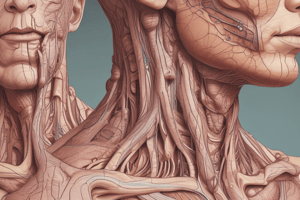Podcast
Questions and Answers
Complete the Concept Map to name the major layers and functions of the ________ and epidermis.
Complete the Concept Map to name the major layers and functions of the ________ and epidermis.
dermis
Surface skin cells regenerate from stem cells found in which specific region?
Surface skin cells regenerate from stem cells found in which specific region?
stratum basale
Which of the following layers is found only on the palms of the hands or the soles of the feet?
Which of the following layers is found only on the palms of the hands or the soles of the feet?
- Stratum granulosum
- Stratum spinosum
- Stratum lucidum (correct)
- Stratum corneum
The integument's ability to resist tearing when stretched is largely due to the ________ present in the reticular layer of the dermis.
The integument's ability to resist tearing when stretched is largely due to the ________ present in the reticular layer of the dermis.
Which epidermal cells act as sensory touch receptors?
Which epidermal cells act as sensory touch receptors?
Which layer is composed primarily of dense irregular connective tissue?
Which layer is composed primarily of dense irregular connective tissue?
Layer B is composed primarily of __________.
Layer B is composed primarily of __________.
Which of these is NOT a function of the layer at D?
Which of these is NOT a function of the layer at D?
Match the following skin pigmentation factors:
Match the following skin pigmentation factors:
Which skin pigment is made in the skin as a natural defense against UV radiation?
Which skin pigment is made in the skin as a natural defense against UV radiation?
Which of the following explains why eyebrows do NOT grow as long as the hair on the head?
Which of the following explains why eyebrows do NOT grow as long as the hair on the head?
The nails can provide signs of health and disease. Which of the following could be a sign of an underlying medical problem?
The nails can provide signs of health and disease. Which of the following could be a sign of an underlying medical problem?
Which glands secrete an oily product that softens the skin and hair?
Which glands secrete an oily product that softens the skin and hair?
Earwax is made by?
Earwax is made by?
Which of the following represents a difference between eccrine sweat glands and apocrine sweat glands?
Which of the following represents a difference between eccrine sweat glands and apocrine sweat glands?
Which skin function is not correctly matched with the structure that accounts for that function?
Which skin function is not correctly matched with the structure that accounts for that function?
Vitamin D precursors are produced in the skin in the presence of sunlight. These chemicals are important for the transport of sodium in our intestines.
Vitamin D precursors are produced in the skin in the presence of sunlight. These chemicals are important for the transport of sodium in our intestines.
The most dangerous type of skin cancer is?
The most dangerous type of skin cancer is?
Susan sat out in the sun watching a baseball game. She developed small blisters on her unprotected shoulders and neck. What type of burn is represented by this?
Susan sat out in the sun watching a baseball game. She developed small blisters on her unprotected shoulders and neck. What type of burn is represented by this?
Flashcards are hidden until you start studying
Study Notes
Skin Regions and Layers
- Major layers of the skin include the epidermis and dermis, each serving distinct functions.
- The stratum basale is where surface skin cells regenerate from stem cells.
- The stratum lucidum is exclusive to the palms and soles, providing a protective layer.
Dermis Composition
- The reticular layer of the dermis contains a network of collagen fibers, enhancing resistance to tearing.
- Layer C consists of dense irregular connective tissue, providing structural integrity.
- Layer B is primarily made of areolar connective tissue, contributing to the skin's flexibility.
Epidermal Cells
- Tactile cells (Merkel cells) in the epidermis are responsible for sensory touch reception.
- Keratinocytes are the most abundant cell type within the epidermis, playing a crucial role in barrier formation.
Cancer Risk and Skin Layers
- Epidermal layer A is least likely to develop cancer, highlighting varying risk levels in skin layers.
Skin Function and Structures
- Structures A, B, C, and D within the dermis serve diverse functions, including lubrication and infection prevention.
- Sebaceous glands secrete an oily substance that softens skin and hair.
- Ceruminous glands are responsible for earwax production.
Skin Pigmentation
- Hemoglobin can alter skin color, particularly in light-skinned individuals, indicating respiratory issues.
- Melanocytes in the epidermis produce melanin, a pigment that protects against UV radiation.
Hair and Nail Characteristics
- Eyebrow hair follicles are short-lived compared to scalp follicles, resulting in shorter hair growth.
- Yellowing nails may signal underlying health problems.
Sweat Gland Differences
- Eccrine and apocrine sweat glands differ in their secretions; apocrine glands produce lipid-rich sweat.
- Apocrine glands are not primarily involved in thermoregulation, contradicting common assumptions.
Vitamin D and Health Implications
- Vitamin D precursors are synthesized in the skin in sunlight, crucial for various health functions, contradicting simplistic health correlations.
Skin Cancer
- Melanoma is identified as the most dangerous form of skin cancer, emphasizing the importance of monitoring skin health.
Sunburn Indicators
- Blisters resulting from sun exposure indicate a second-degree burn, a sign of skin damage from UV radiation.
Studying That Suits You
Use AI to generate personalized quizzes and flashcards to suit your learning preferences.





